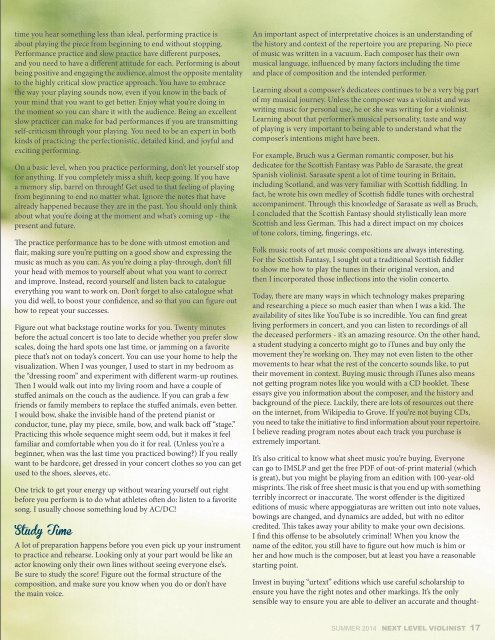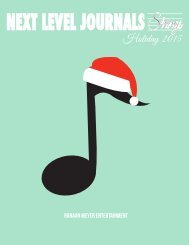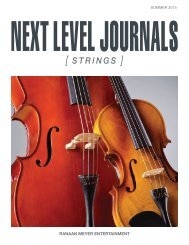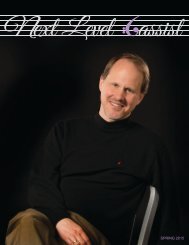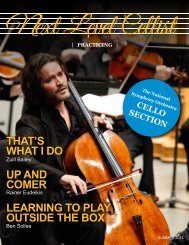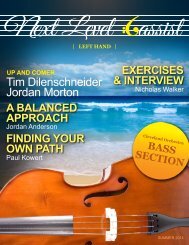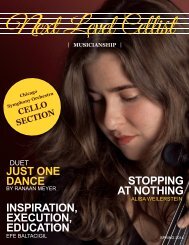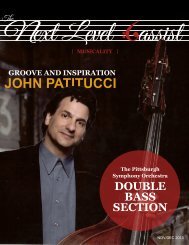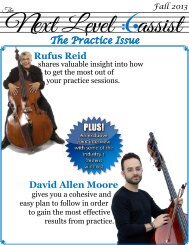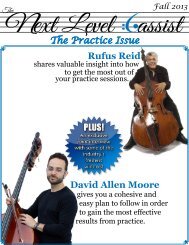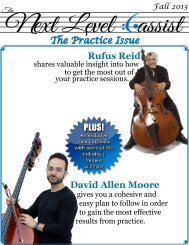Next Level Violinist Practicing Issue
The Summer issue of Next Level Violinist, the free online journal for violinists of all levels and ages. Featuring articles and interviews by Alex Kerr, Rachel Barton Pine, and Eunice Kim. Visit www.nextleveljournals.com to become a member.
The Summer issue of Next Level Violinist, the free online journal for violinists of all levels and ages. Featuring articles and interviews by Alex Kerr, Rachel Barton Pine, and Eunice Kim. Visit www.nextleveljournals.com to become a member.
You also want an ePaper? Increase the reach of your titles
YUMPU automatically turns print PDFs into web optimized ePapers that Google loves.
time you hear something less than ideal, performing practice is<br />
about playing the piece from beginning to end without stopping.<br />
Performance practice and slow practice have different purposes,<br />
and you need to have a different attitude for each. Performing is about<br />
being positive and engaging the audience, almost the opposite mentality<br />
to the highly critical slow practice approach. You have to embrace<br />
the way your playing sounds now, even if you know in the back of<br />
your mind that you want to get better. Enjoy what you’re doing in<br />
the moment so you can share it with the audience. Being an excellent<br />
slow practicer can make for bad performances if you are transmitting<br />
self-criticism through your playing. You need to be an expert in both<br />
kinds of practicing: the perfectionistic, detailed kind, and joyful and<br />
exciting performing.<br />
On a basic level, when you practice performing, don’t let yourself stop<br />
for anything. If you completely miss a shift, keep going. If you have<br />
a memory slip, barrel on through! Get used to that feeling of playing<br />
from beginning to end no matter what. Ignore the notes that have<br />
already happened because they are in the past. You should only think<br />
about what you’re doing at the moment and what’s coming up - the<br />
present and future.<br />
The practice performance has to be done with utmost emotion and<br />
flair, making sure you’re putting on a good show and expressing the<br />
music as much as you can. As you’re doing a play-through, don’t fill<br />
your head with memos to yourself about what you want to correct<br />
and improve. Instead, record yourself and listen back to catalogue<br />
everything you want to work on. Don’t forget to also catalogue what<br />
you did well, to boost your confidence, and so that you can figure out<br />
how to repeat your successes.<br />
Figure out what backstage routine works for you. Twenty minutes<br />
before the actual concert is too late to decide whether you prefer slow<br />
scales, doing the hard spots one last time, or jamming on a favorite<br />
piece that’s not on today’s concert. You can use your home to help the<br />
visualization. When I was younger, I used to start in my bedroom as<br />
the “dressing room” and experiment with different warm-up routines.<br />
Then I would walk out into my living room and have a couple of<br />
stuffed animals on the couch as the audience. If you can grab a few<br />
friends or family members to replace the stuffed animals, even better.<br />
I would bow, shake the invisible hand of the pretend pianist or<br />
conductor, tune, play my piece, smile, bow, and walk back off “stage.”<br />
<strong>Practicing</strong> this whole sequence might seem odd, but it makes it feel<br />
familiar and comfortable when you do it for real. (Unless you’re a<br />
beginner, when was the last time you practiced bowing?) If you really<br />
want to be hardcore, get dressed in your concert clothes so you can get<br />
used to the shoes, sleeves, etc.<br />
One trick to get your energy up without wearing yourself out right<br />
before you perform is to do what athletes often do: listen to a favorite<br />
song. I usually choose something loud by AC/DC!<br />
<br />
A lot of preparation happens before you even pick up your instrument<br />
to practice and rehearse. Looking only at your part would be like an<br />
actor knowing only their own lines without seeing everyone else’s.<br />
Be sure to study the score! Figure out the formal structure of the<br />
composition, and make sure you know when you do or don’t have<br />
the main voice.<br />
An important aspect of interpretative choices is an understanding of<br />
the history and context of the repertoire you are preparing. No piece<br />
of music was written in a vacuum. Each composer has their own<br />
musical language, influenced by many factors including the time<br />
and place of composition and the intended performer.<br />
Learning about a composer’s dedicatees continues to be a very big part<br />
of my musical journey. Unless the composer was a violinist and was<br />
writing music for personal use, he or she was writing for a violinist.<br />
Learning about that performer’s musical personality, taste and way<br />
of playing is very important to being able to understand what the<br />
composer’s intentions might have been.<br />
For example, Bruch was a German romantic composer, but his<br />
dedicatee for the Scottish Fantasy was Pablo de Sarasate, the great<br />
Spanish violinist. Sarasate spent a lot of time touring in Britain,<br />
including Scotland, and was very familiar with Scottish fiddling. In<br />
fact, he wrote his own medley of Scottish fiddle tunes with orchestral<br />
accompaniment. Through this knowledge of Sarasate as well as Bruch,<br />
I concluded that the Scottish Fantasy should stylistically lean more<br />
Scottish and less German. This had a direct impact on my choices<br />
of tone colors, timing, fingerings, etc.<br />
Folk music roots of art music compositions are always interesting.<br />
For the Scottish Fantasy, I sought out a traditional Scottish fiddler<br />
to show me how to play the tunes in their original version, and<br />
then I incorporated those inflections into the violin concerto.<br />
Today, there are many ways in which technology makes preparing<br />
and researching a piece so much easier than when I was a kid. The<br />
availability of sites like YouTube is so incredible. You can find great<br />
living performers in concert, and you can listen to recordings of all<br />
the deceased performers - it’s an amazing resource. On the other hand,<br />
a student studying a concerto might go to iTunes and buy only the<br />
movement they’re working on. They may not even listen to the other<br />
movements to hear what the rest of the concerto sounds like, to put<br />
their movement in context. Buying music through iTunes also means<br />
not getting program notes like you would with a CD booklet. These<br />
essays give you information about the composer, and the history and<br />
background of the piece. Luckily, there are lots of resources out there<br />
on the internet, from Wikipedia to Grove. If you’re not buying CDs,<br />
you need to take the initiative to find information about your repertoire.<br />
I believe reading program notes about each track you purchase is<br />
extremely important.<br />
It’s also critical to know what sheet music you’re buying. Everyone<br />
can go to IMSLP and get the free PDF of out-of-print material (which<br />
is great), but you might be playing from an edition with 100-year-old<br />
misprints. The risk of free sheet music is that you end up with something<br />
terribly incorrect or inaccurate. The worst offender is the digitized<br />
editions of music where appoggiaturas are written out into note values,<br />
bowings are changed, and dynamics are added, but with no editor<br />
credited. This takes away your ability to make your own decisions.<br />
I find this offense to be absolutely criminal! When you know the<br />
name of the editor, you still have to figure out how much is him or<br />
her and how much is the composer, but at least you have a reasonable<br />
starting point.<br />
Invest in buying “urtext” editions which use careful scholarship to<br />
ensure you have the right notes and other markings. It’s the only<br />
sensible way to ensure you are able to deliver an accurate and thought-<br />
SUMMER 2014 NEXT LEVEL VIOLINIST 17


